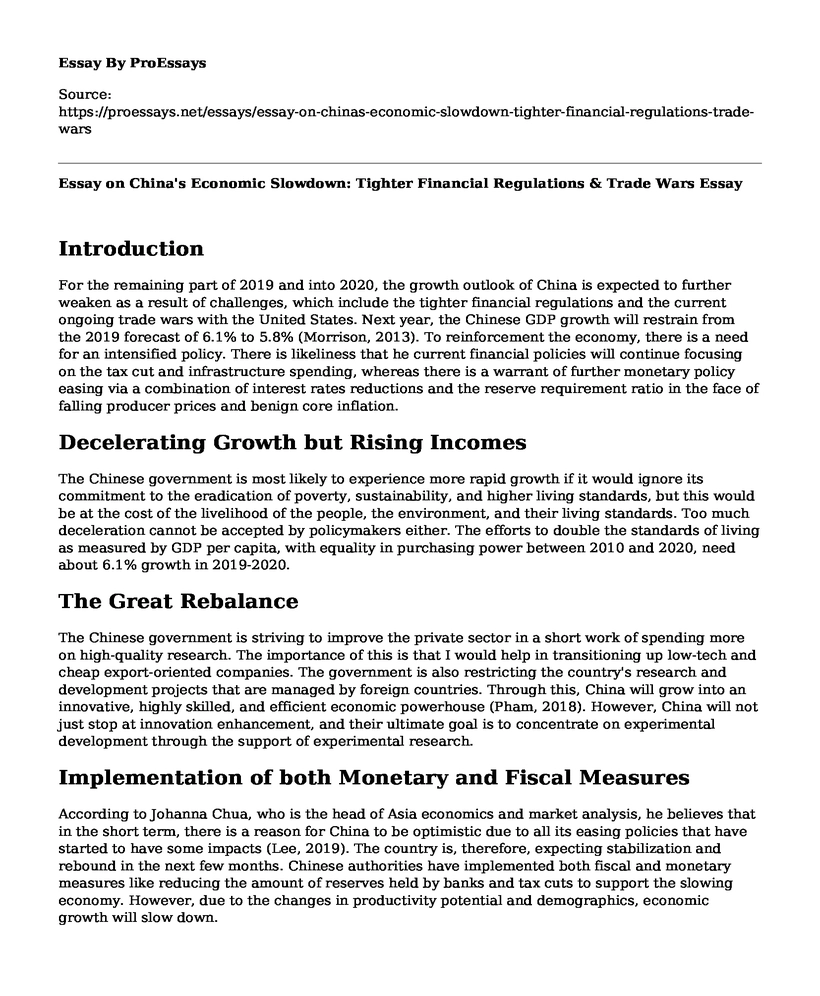Introduction
For the remaining part of 2019 and into 2020, the growth outlook of China is expected to further weaken as a result of challenges, which include the tighter financial regulations and the current ongoing trade wars with the United States. Next year, the Chinese GDP growth will restrain from the 2019 forecast of 6.1% to 5.8% (Morrison, 2013). To reinforcement the economy, there is a need for an intensified policy. There is likeliness that he current financial policies will continue focusing on the tax cut and infrastructure spending, whereas there is a warrant of further monetary policy easing via a combination of interest rates reductions and the reserve requirement ratio in the face of falling producer prices and benign core inflation.
Decelerating Growth but Rising Incomes
The Chinese government is most likely to experience more rapid growth if it would ignore its commitment to the eradication of poverty, sustainability, and higher living standards, but this would be at the cost of the livelihood of the people, the environment, and their living standards. Too much deceleration cannot be accepted by policymakers either. The efforts to double the standards of living as measured by GDP per capita, with equality in purchasing power between 2010 and 2020, need about 6.1% growth in 2019-2020.
The Great Rebalance
The Chinese government is striving to improve the private sector in a short work of spending more on high-quality research. The importance of this is that I would help in transitioning up low-tech and cheap export-oriented companies. The government is also restricting the country's research and development projects that are managed by foreign countries. Through this, China will grow into an innovative, highly skilled, and efficient economic powerhouse (Pham, 2018). However, China will not just stop at innovation enhancement, and their ultimate goal is to concentrate on experimental development through the support of experimental research.
Implementation of both Monetary and Fiscal Measures
According to Johanna Chua, who is the head of Asia economics and market analysis, he believes that in the short term, there is a reason for China to be optimistic due to all its easing policies that have started to have some impacts (Lee, 2019). The country is, therefore, expecting stabilization and rebound in the next few months. Chinese authorities have implemented both fiscal and monetary measures like reducing the amount of reserves held by banks and tax cuts to support the slowing economy. However, due to the changes in productivity potential and demographics, economic growth will slow down.
Analysis
The economy of China depends on various factors, both internal and external. The internal factors include the policymakers' decisions, such as the implementation of monetary and fiscal measures to improve the investment index of the people. Innovation is also a significant contributor to the county's economic growth, and China has put in place measures to enhance advancement in its innovation through the improvement of experimental development. External factors can also not be ignored, and one such significant factors are the trade war between China and the U.S that has continued to have negative impacts on Chinese exports.
Conclusion
There are several indicators to prove this, and among them include the decelerating growth and increasing incomes, which would imply an improved living standard among the Chinese people. Another one is the great rebalance whereby the private sector is developed to subsidy the government sector. Lastly is the implementation of both monetary and fiscal measures, which are expected to result in stabilization in the Chinese economy. Therefore, it is clear that China is forecasted to have positive economic growth in the near term.
References
Lee Y. N. (2019). IMF raises its 2019 growth forecast for China. China Economy. CNBC. https://www.cnbc.com/2019/04/10/imf-raises-growth-forecast-for-china-on-policy-support-trade-outlook.html
Morrison, W. M. (2013). China's economic rise: history, trends, challenges, and implications for the United States (pp. 20-22). Washington, DC: Congressional Research Service. https://www.everycrsreport.com/files/20150911_RL33534_7d506d97ac04bd17c079bd8791c8dfee1da3eb65.pdf
Pham P. (2018). What Will China's Future Look Like? Forbes. https://www.forbes.com/sites/peterpham/2018/03/07/what-will-chinas-future-look-like/#30c84ffa7488
Cite this page
Essay on China's Economic Slowdown: Tighter Financial Regulations & Trade Wars. (2023, Mar 02). Retrieved from https://proessays.net/essays/essay-on-chinas-economic-slowdown-tighter-financial-regulations-trade-wars
If you are the original author of this essay and no longer wish to have it published on the ProEssays website, please click below to request its removal:
- African Musical Elements and American Musical Culture
- Sources and Uses of Cash Paper Example
- Research Paper on Migration: Causes, Outcomes, and Challenges in the Modern World
- Essay Example on DNA: The Unique Identity Code for All Living Organisms
- Essay Example on California Homelessness: 500K Affordable Houses Needed Annually
- Essay Example on U.S. Sanctions on Venezuela: Global Power Struggle?
- Paper Example on Police Procedurals: Evolving in American TV Over Decades







